High Throughput Direct Laser Interference Patterning of Aluminum for Fabrication of Super Hydrophobic Surfaces
Abstract
1. Introduction
2. Materials and Methods
2.1. Materials
2.2. Direct Laser Interference Patterning
2.3. Surface Characterization
2.4. Modelling of Heat Accumulation
2.5. Modelling of Surface Wettability
3. Results and Discussion
4. Conclusions
Author Contributions
Funding
Conflicts of Interest
References
- Bernardin, J.D.; Mudawar, I.; Walsh, C.B.; Franses, E.I. Contact angle temperature dependence for water droplets on practical aluminum surfaces. Int. J. Heat Mass Transf. 1997, 40, 1017–1033. [Google Scholar] [CrossRef]
- Starke, E.A.; Staley, J.T. Application of modern aluminum alloys to aircraft. Prog. Aerosp. Sci. 1996, 32, 131–172. [Google Scholar] [CrossRef]
- Dursun, T.; Soutis, C. Recent developments in advanced aircraft aluminium alloys. Mater. Des. 2014, 56, 862–871. [Google Scholar] [CrossRef]
- Hirsch, J. Recent development in aluminium for automotive applications. T. Nonferr. Metal. Soc. 2014, 24, 1995–2002. [Google Scholar] [CrossRef]
- Miller, W.S.; Zhuang, L.; Bottema, J.; Wittebrood, A.; de Smet, P.; Haszler, A.; Vieregge, A. Recent development in aluminium alloys for the automotive industry. Mater. Sci. Eng. A 2000, 280, 37–49. [Google Scholar] [CrossRef]
- Hirsch, J. Aluminium alloys for automotive application. In Materials Science Forum; Trans Tech Publications: Zurich, Switzerland, 1997; Volume 242, pp. 33–50. [Google Scholar]
- Ferraris, S.; Volpone, L.M. Aluminium Alloys in Third Millennium Shipbuilding: Materials, Technologies, Perspectives; The Fifth International Forum on Aluminium Ships: Tokyo, Japan, 2005. [Google Scholar]
- Vargel, C. Corrosion of Aluminium; Elsevier: Amsterdam, The Netherlands, 2004. [Google Scholar]
- Anderson, T. New developments within the Aluminium Shipbuilding Industry. Svetsaren 2003, 58, 3–5. [Google Scholar]
- Wang, T.A.; Reid, R.L. Surface wettability effect on an indirect evaporative cooling system. ASHRAE Trans. 1996, 102, 427–433. [Google Scholar]
- Kim, M.-H.; Bullard, C.W. Air-side performance of brazed aluminum heat exchangers under dehumidifying conditions. Int. J. Refrig. 2002, 25, 924–934. [Google Scholar] [CrossRef]
- Lin, Z.; Wang, S.; Huo, J.; Hu, Y.; Chen, J.; Zhang, W.; Lee, E. Heat transfer characteristics and LED heat sink application of aluminum plate oscillating heat pipes. Appl. Therm. Eng. 2011, 31, 2221–2229. [Google Scholar] [CrossRef]
- Ni, L.; Chemtob, A.; Croutxé-Barghorn, C.; Moreau, N.; Bouder, T.; Chanfreau, S.; Pébère, N. Direct-to-metal UV-cured hybrid coating for the corrosion protection of aircraft aluminium alloy. Corros. Sci. 2014, 89, 242–249. [Google Scholar] [CrossRef]
- Sommers, A.D.; Jacobi, A.M. Creating micro-scale surface topology to achieve anisotropic wettability on an aluminum surface. J. Micromech. Microeng. 2006, 16, 1571–1578. [Google Scholar] [CrossRef]
- Haines, P.; Luers, J. Aerodynamic penalties of heavy rain on landing airplanes. J. Aircr. 1983, 20, 111–119. [Google Scholar] [CrossRef]
- Hansman, R.J.; Barsotti, M.F. Surface wetting effects on a laminar flow airfoil in simulated heavyrain. J. Aircr. 1985, 22, 1049–1053. [Google Scholar] [CrossRef]
- Boinovich, L.B.; Domantovskii, A.G.; Emelyanenko, A.M.; Miller, A.B.; Potapov, Y.F.; Khodan, A.N. Antiicing performance of superhydrophobic coatings on aluminum and stainless steel. Russ. Chem. Bull. 2013, 62, 380–387. [Google Scholar] [CrossRef]
- Thomas, S.K.; Cassoni, R.P.; MacArthur, C.D. Aircraft anti-icing and de-icing techniques and modeling. J. Aircr. 1996, 33, 841–854. [Google Scholar] [CrossRef]
- Farzaneh, M.; Ryerson, C.C. Anti-icing and deicing techniques. Cold Reg. Sci. Technol. 2011, 65, 1–4. [Google Scholar] [CrossRef]
- Kulinich, S.A.; Farzaneh, M. On ice-releasing properties of rough hydrophobic coatings. Cold Reg. Sci. Technol. 2011, 65, 60–64. [Google Scholar] [CrossRef]
- Farhadi, S.; Farzaneh, M.; Kulinich, S.A. Anti-icing performance of superhydrophobic surfaces. Appl. Surf. Sci. 2011, 257, 6264–6269. [Google Scholar] [CrossRef]
- Dotan, A.; Dodiuk, H.; Laforte, C.; Kenig, S. The Relationship between Water Wetting and Ice Adhesion. J. Adhes. Sci. Technol. 2009, 23, 1907–1915. [Google Scholar] [CrossRef]
- Ruan, M.; Li, W.; Wang, B.; Deng, B.; Ma, F.; Yu, Z. Preparation and anti-icing behavior of superhydrophobic surfaces on aluminum alloy substrates. Langmuir 2013, 29, 8482–8491. [Google Scholar] [CrossRef]
- Na, B.; Webb, R.L. A fundamental understanding of factors affecting frost nucleation. Int. J. Heat Mass Transf. 2003, 46, 3797–3808. [Google Scholar] [CrossRef]
- Menini, R.; Farzaneh, M. Elaboration of Al2O3/PTFE icephobic coatings for protecting aluminum surfaces. Surf. Coat. Technol. 2009, 203, 1941–1946. [Google Scholar] [CrossRef]
- Menini, R.; Ghalmi, Z.; Farzaneh, M. Highly resistant icephobic coatings on aluminum alloys. Cold Reg. Sci. Technol. 2011, 65, 65–69. [Google Scholar] [CrossRef]
- Saleema, N.; Farzaneh, M.; Paynter, R.W.; Sarkar, D.K. Prevention of Ice Accretion on Aluminum Surfaces by Enhancing Their Hydrophobic Properties. J. Adhes. Sci. Technol. 2012, 25, 27–40. [Google Scholar] [CrossRef]
- Guo, P.; Zheng, Y.; Wen, M.; Song, C.; Lin, Y.; Jiang, L. Icephobic/anti-icing properties of micro/nanostructured surfaces. Adv. Mater. Weinheim 2012, 24, 2642–2648. [Google Scholar] [CrossRef] [PubMed]
- Del Cerro, D.A.; Roemer, G.; HUIS IN ‘T VELD, A.J. Picosecond laser machined designed patterns with anti-ice effect. Proc. LPM2010 2010, 5, 1–4. [Google Scholar]
- Liu, Y.; Li, X.; Jin, J.; Liu, J.; Yan, Y.; Han, Z.; Ren, L. Anti-icing property of bio-inspired micro-structure superhydrophobic surfaces and heat transfer model. Appl. Surf. Sci. 2017, 400, 498–505. [Google Scholar] [CrossRef]
- Lasagni, A.; Benke, D.; Kunze, T.; Bieda, M.; Eckhardt, S.; Roch, T.; Langheinrich, D.; Berger, J. Bringing the direct laser interference patterning method to industry: a one tool-complete solution for surface functionalization. J. Laser Micro. Nanoen. 2015, 10, 340–345. [Google Scholar] [CrossRef]
- Lasagni, A.F.; Roch, T.; Berger, J.; Kunze, T.; Lang, V.; Beyer, E. To use or not to use (direct laser interference patterning), that is the question. In Laser-based Micro-and Nanoprocessing IX; International Society for Optics and Photonics: San Francisco, CA, USA, 2015; Volume 9351, p. 935115. [Google Scholar]
- Bieda, M.; Beyer, E.; Lasagni, A.F. Direct Fabrication of Hierarchical Microstructures on Metals by Means of Direct Laser Interference Patterning. J. Eng. Mater. Technol. 2010, 132, 31015. [Google Scholar] [CrossRef]
- Mücklich, F.; Lasagni, A.; Daniel, C. Laser Interference Metallurgy-using interference as a tool for micro/nano structuring. Z. Metallkd. 2006, 97, 1337–1344. [Google Scholar] [CrossRef]
- Knowles, M.R.; Rutterford, G.; Bell, A.I.; Andrews, A.J.; Foster-Turner, G.; Kearsley, A.J.; Coutts, D.W.; Kapitan, D.; Webb, C.E. Sub-micron and high precision micro-machining using nanosecond lasers. In ICALEO 98: Proceedings of the Laser Materials Processing Conference; ICALEO: Orlando, FL, USA, 1998; Volume 1998, pp. E112–E120. [Google Scholar]
- Kelly, M.K.; Rogg, J.; Nebel, C.E.; Stutzmann, M.; Kátai, S. High-Resolution Thermal Processing of Semiconductors Using Pulsed-Laser Interference Patterning. Phys. Status Solidi A 1998, 166, 651–657. [Google Scholar] [CrossRef]
- Rößler, F.; Kunze, T.; Lasagni, A.F. Fabrication of diffraction based security elements using direct laser interference patterning. Opt. Express 2017, 25, 22959–22970. [Google Scholar] [CrossRef]
- Indrišiūnas, S.; Voisiat, B.; Račiukaitis, G. Fabrication of Micro-Size Structures using Scanned Interference Pattern. Phys. Procedia 2013, 41, 727–733. [Google Scholar] [CrossRef]
- Kondo, T.; Matsuo, S.; Juodkazis, S.; Misawa, H. Femtosecond laser interference technique with diffractive beam splitter for fabrication of three-dimensional photonic crystals. Appl. Phys. Lett. 2001, 79, 725–727. [Google Scholar] [CrossRef]
- Lang, V.; Hoffmann, T.; Lasagni, A.-F. Optimization for high speed surface processing of metallic surfaces utilizing direct laser interference patterning. In Proceedings of SPIE; International Society for Optics and Photonics: San Francisco, CA, USA; Volume 10520, pp. 1–10.
- Stankevičius, E.; Garliauskas, M.; Račiukaitis, G. Bessel-like Beam Array Generation Using Round-tip Micro-structures and Their Use in the Material Treatment. J. Laser Micro Nanoen. 2016, 11, 352–356. [Google Scholar]
- Molotokaite, E.; Gedvilas, M.; Račiukaitis, G.; Girdauskas, V. Picosecond Laser Beam Interference Ablation of Thin Metal Films on Glass Substrate. J. Laser Micro Nanoen. 2010, 5, 74–79. [Google Scholar] [CrossRef]
- Hesse, W. Aluminium-Werkstoff-Datenblätter: Deutsch/Englisch, 7th ed.; Beuth Verlag: Berlin, Germany, 2016; pp. 185–195. [Google Scholar]
- Weber, R.; Graf, T.; Berger, P.; Onuseit, V.; Wiedenmann, M.; Freitag, C.; Feuer, A. Heat accumulation during pulsed laser materials processing. Opt. Express 2014, 22, 11312–11324. [Google Scholar] [CrossRef]
- Wenzel, R.N. Resistance of solid surfaces to wetting by water. Ind. Eng. Chem. 1936, 28, 988–994. [Google Scholar] [CrossRef]
- Marmur, A. Wetting on Hydrophobic Rough Surfaces: To Be Heterogeneous or Not To Be? Langmuir 2003, 19, 8343–8348. [Google Scholar] [CrossRef]
- Cassie, A.B.D.; Baxter, S. Wettability of porous surfaces. Trans. Faraday Soc. 1944, 40, 546. [Google Scholar] [CrossRef]
- Lang, V.; Voisiat, B.; Lasagni, A.F. Fabrication of High Aspect-Ratio Surface Micro Patterns on Stainless Steel using High-Speed Direct Laser Interference Patterning. Adv. Eng. Mater. 2019, 1900151. [Google Scholar] [CrossRef]
- Illgner, C.; Schaaf, P.; Lieb, K.-P.; Queitsch, R.; Barnikel, J. Material transport during excimer-laser nitriding of iron. J. Appl. Phys. 1998, 83, 2907–2914. [Google Scholar] [CrossRef]
- Semak, V.V.; Steele, R.J.; Fuerschbach, P.W.; Damkroger, B.K. Role of beam absorption in plasma during laser welding. J. Phys. D Appl. Phys. 2000, 33, 1179. [Google Scholar] [CrossRef][Green Version]
- Hamedi, M.J.; Torkamany, M.J.; Sabbaghzadeh, J. Effect of pulsed laser parameters on in-situ TiC synthesis in laser surface treatment. Opt. Lasers Eng. 2011, 49, 557–563. [Google Scholar] [CrossRef]
- Zhou, J.; Tsai, H.-L.; Wang, P.-C. Transport phenomena and keyhole dynamics during pulsed laser welding. J. Heat Transf. 2006, 128, 680–690. [Google Scholar] [CrossRef]
- Bennett, T.D.; Krajnovich, D.J.; Grigoropoulos, C.P.; Baumgart, P.; Tam, A.C. Marangoni mechanism in pulsed laser texturing of magnetic disk substrates. J. Heat Transf. 1997, 119, 589–596. [Google Scholar] [CrossRef]
- Voisiat, B.; Zwahr, C.; Lasagni, A.F. Growth of regular micro-pillar arrays on steel by polarization-controlled laser interference patterning. Appl. Surf. Sci. 2019, 471, 1065–1071. [Google Scholar] [CrossRef]
- D’Alessandria, M.; Lasagni, A.F.; Mücklich, F. Direct micro-patterning of aluminum substrates via laser interference metallurgy. Appl. Surf. Sci. 2008, 255, 3210–3216. [Google Scholar]
- Long, J.; Pan, L.; Fan, P.; Gong, D.; Jiang, D.; Zhang, H.; Li, L.; Zhong, M. Cassie-State Stability of Metallic Superhydrophobic Surfaces with Various Micro/Nanostructures Produced by a Femtosecond Laser. Langmuir 2016, 32, 1065–1072. [Google Scholar] [CrossRef]
- Su, Y.; Ji, B.; Zhang, K.; Gao, H.; Huang, Y.; Hwang, K. Nano to Micro Structural Hierarchy Is Crucial for Stable Superhydrophobic and Water-Repellent Surfaces. Langmuir 2010, 26, 4984–4989. [Google Scholar] [CrossRef] [PubMed]
- Whyman, G.; Bormashenko, E. How to Make the Cassie Wetting State Stable? Langmuir 2011, 27, 8171–8176. [Google Scholar] [CrossRef] [PubMed]
- Kietzig, A.-M.; Hatzikiriakos, S.G.; Englezos, P. Patterned Superhydrophobic Metallic Surfaces. Langmuir 2009, 25, 4821–4827. [Google Scholar] [CrossRef] [PubMed]
- Milles, S.; Voisiat, B.; Nitschke, M.; Lasagni, A.F. Influence of roughness achieved by periodic structures on the wettability of aluminum using direct laser writing and direct laser interference patterning technology. J. Mater. Process. Technol. 2019, 270, 142–151. [Google Scholar] [CrossRef]

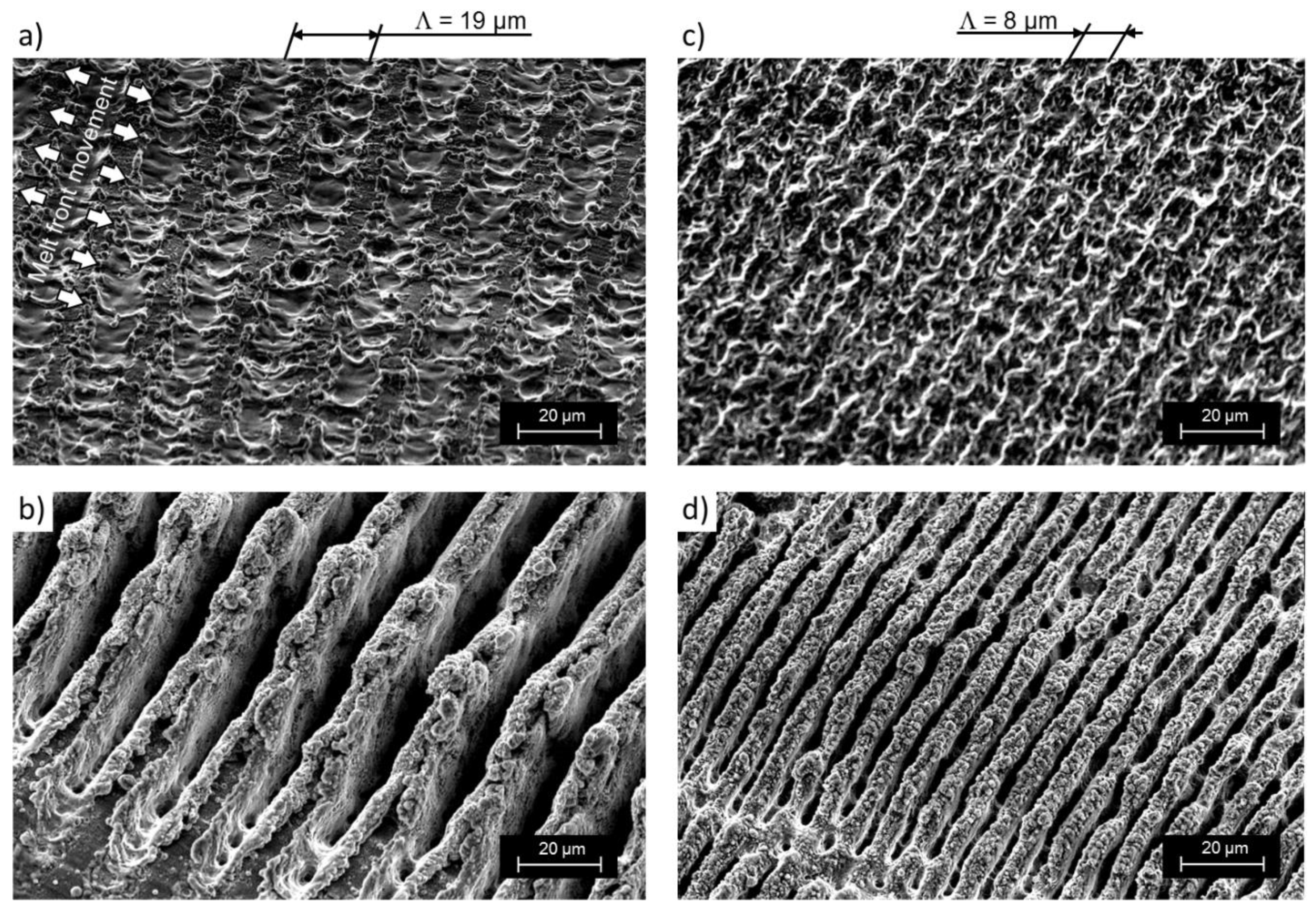

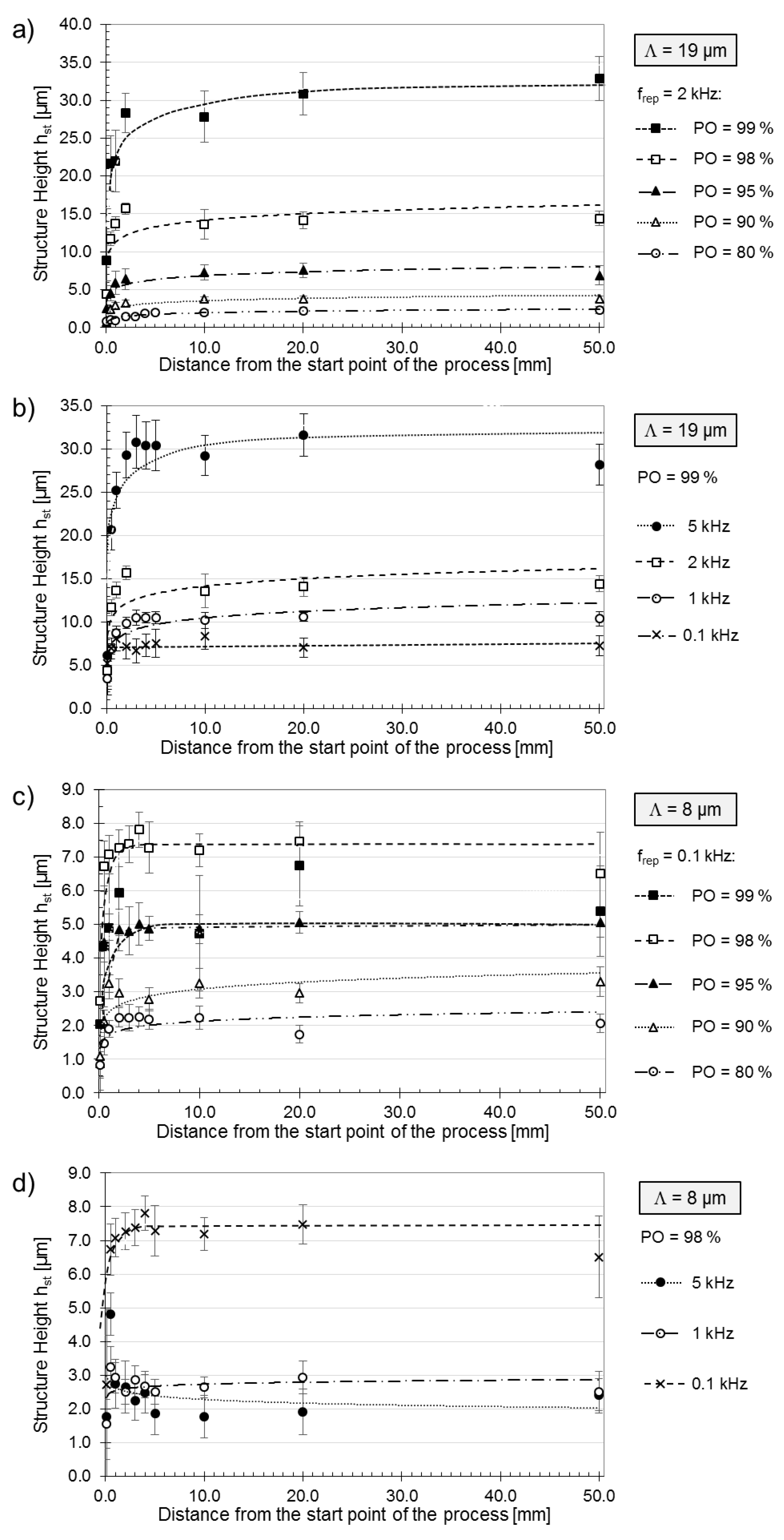

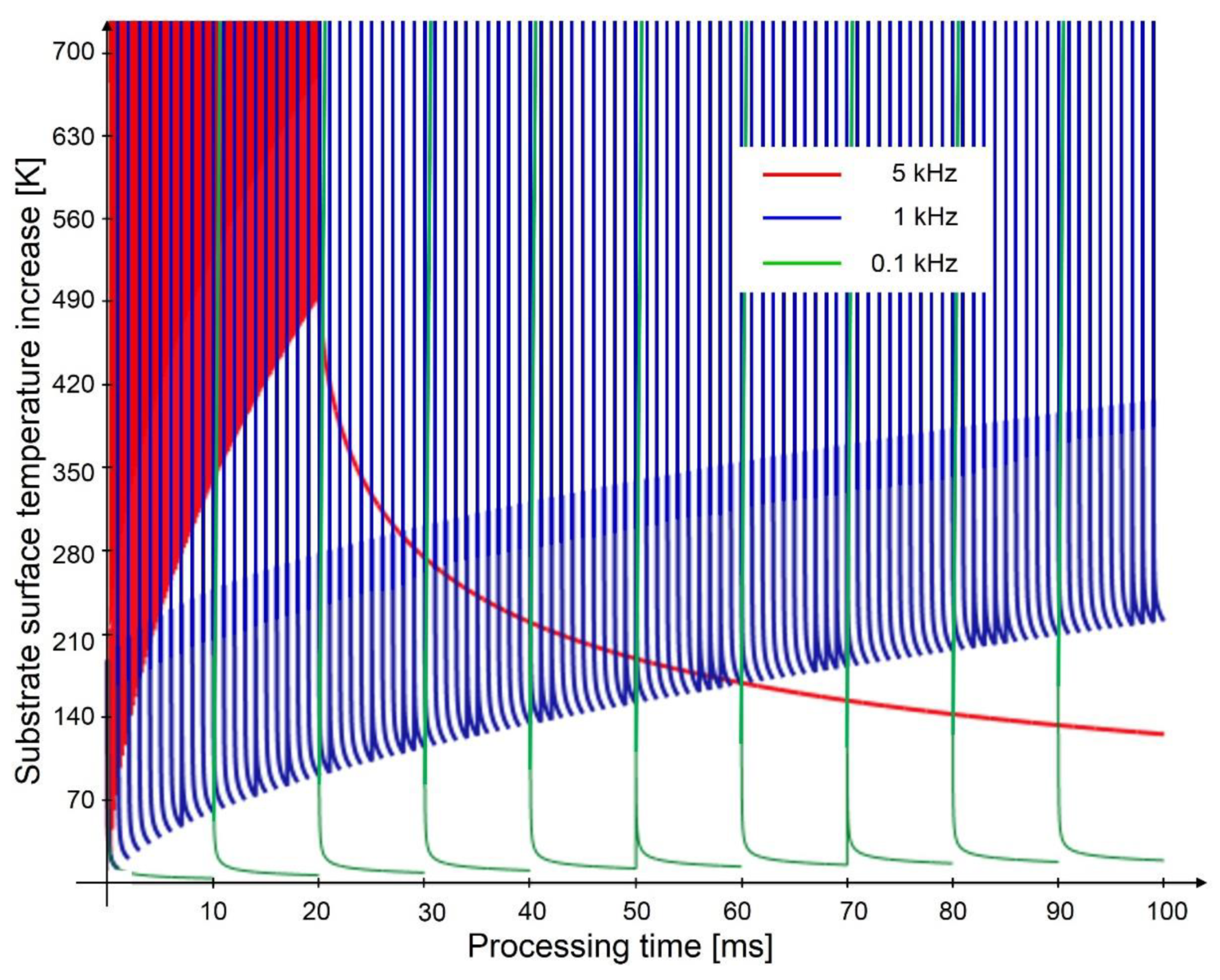
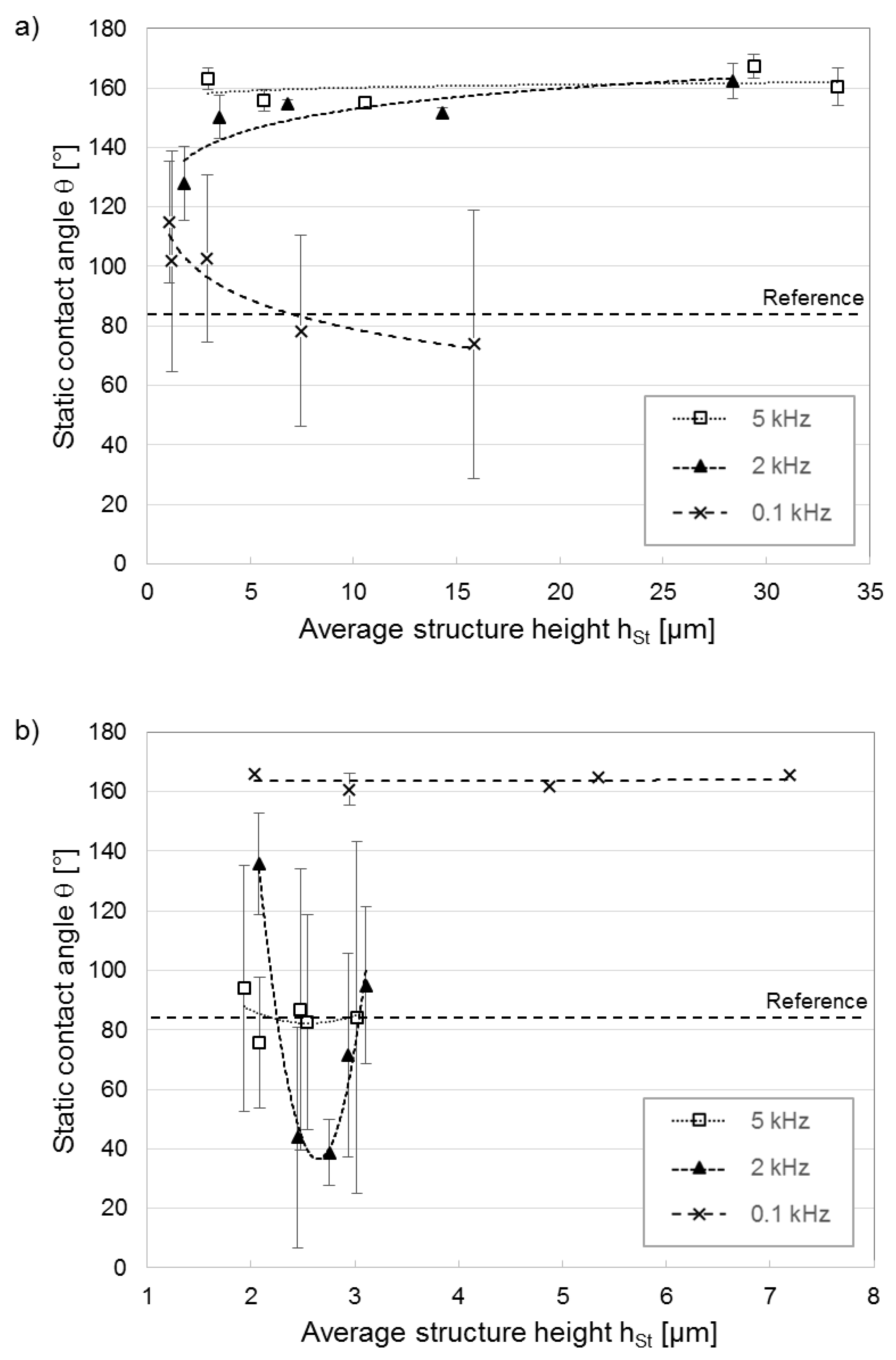
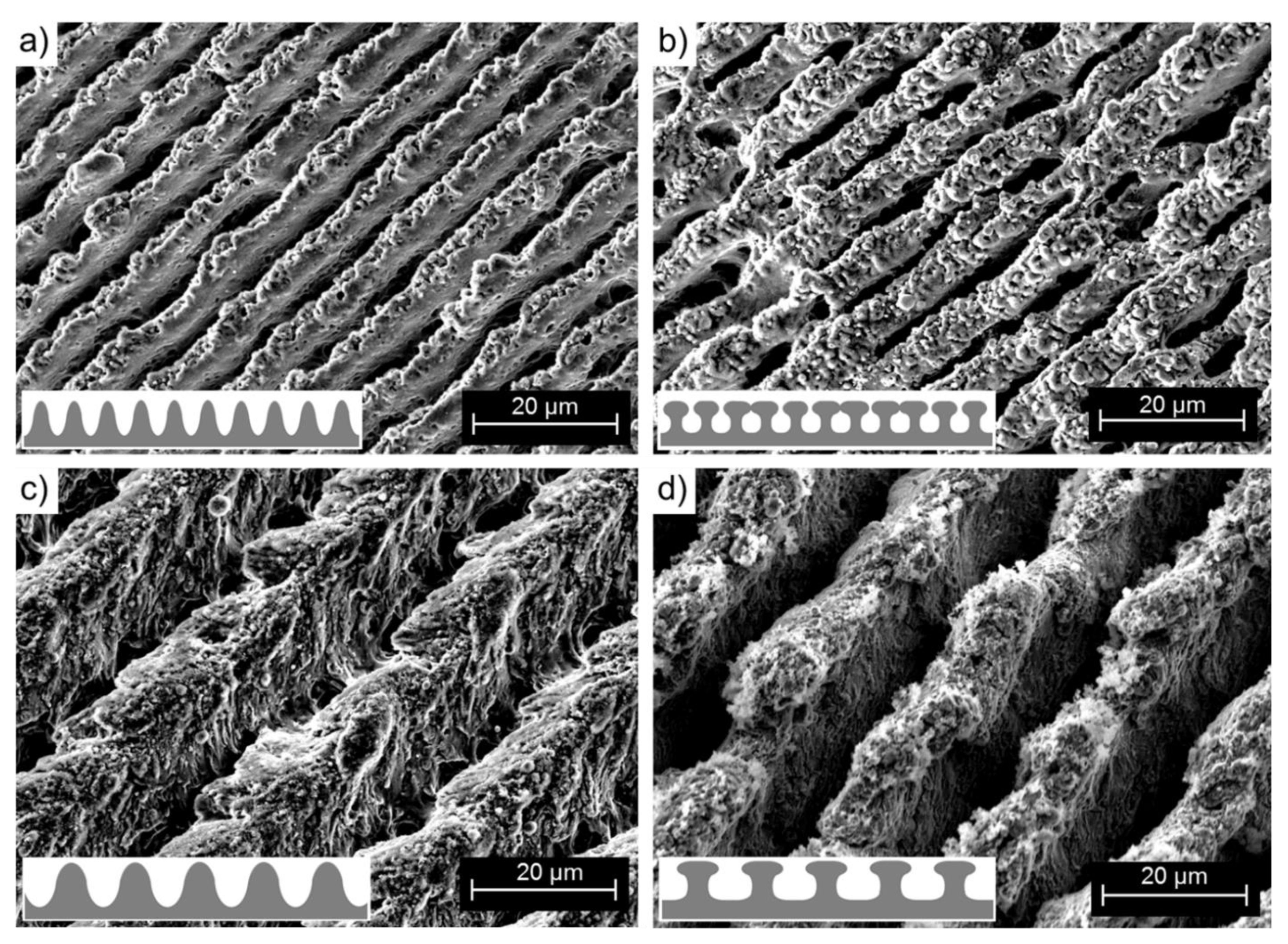
| Parameter | Symbol | Unit | Value |
|---|---|---|---|
| Density | ρ | kg∙m−3 | 2698.9 |
| Thermal diffusivity | κ | m2·s−1 | 98.8 × 10−6 |
| Specific heat capacity | cp | J∙(kg·K)−1 | 896 |
| Interference Period (µm) | Laser Pulse Rep. Rate (kHz) | Structure Height (µm) | Measured Contact Angle (°) | Calc. CA (Wenzel) (°) | Calc. CA (Cassie-Baxter) (°) |
|---|---|---|---|---|---|
| 19.0 | 0.1 | 15.8 | 73.8 | 79.9 | 143.4 |
| 19.0 | 2.0 | 14.3 | 151.7 | 80.6 | 144.4 |
| 19.0 | 5.0 | 10.5 | 154.9 | 82.2 | 145.4 |
| 8.0 | 0.1 | 3.0 | 160.8 | 83.6 | 135.5 |
| 8.0 | 2.0 | 2.9 | 72.4 | 82.6 | 134.7 |
| 8.0 | 5.0 | 3.0 | 84.2 | 83.5 | 136.3 |
© 2019 by the authors. Licensee MDPI, Basel, Switzerland. This article is an open access article distributed under the terms and conditions of the Creative Commons Attribution (CC BY) license (http://creativecommons.org/licenses/by/4.0/).
Share and Cite
Lang, V.; Voisiat, B.; Lasagni, A.F. High Throughput Direct Laser Interference Patterning of Aluminum for Fabrication of Super Hydrophobic Surfaces. Materials 2019, 12, 1484. https://doi.org/10.3390/ma12091484
Lang V, Voisiat B, Lasagni AF. High Throughput Direct Laser Interference Patterning of Aluminum for Fabrication of Super Hydrophobic Surfaces. Materials. 2019; 12(9):1484. https://doi.org/10.3390/ma12091484
Chicago/Turabian StyleLang, Valentin, Bogdan Voisiat, and Andrés Fabián Lasagni. 2019. "High Throughput Direct Laser Interference Patterning of Aluminum for Fabrication of Super Hydrophobic Surfaces" Materials 12, no. 9: 1484. https://doi.org/10.3390/ma12091484
APA StyleLang, V., Voisiat, B., & Lasagni, A. F. (2019). High Throughput Direct Laser Interference Patterning of Aluminum for Fabrication of Super Hydrophobic Surfaces. Materials, 12(9), 1484. https://doi.org/10.3390/ma12091484






